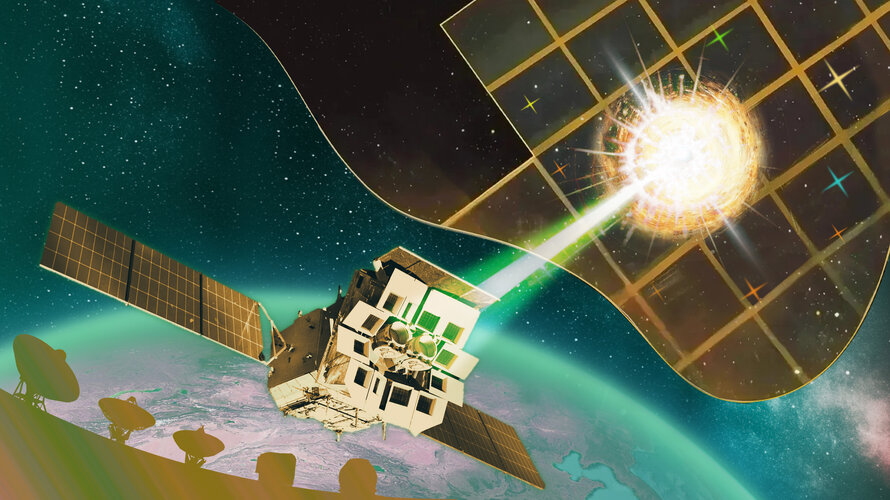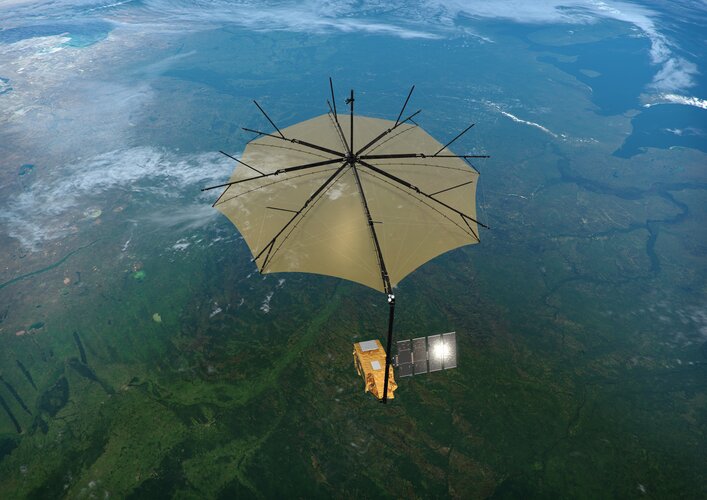
Copernical Team
Thursday, 23 January 2025 09:11
Top Beijing official urges Musk to deepen ties with China: state media
Beijing (AFP) Jan 20, 2025
 Chinese Vice President Han Zheng met with tech tycoon Elon Musk and urged US firms to "seize the opportunity" to deepen economic ties with China, Beijing's state media said Monday.
Han - who is set to attend the inauguration of US President-elect Donald Trump later on Monday - met with Musk and other American business representatives on Sunday, Xinhua said.
The world's richest person,
Chinese Vice President Han Zheng met with tech tycoon Elon Musk and urged US firms to "seize the opportunity" to deepen economic ties with China, Beijing's state media said Monday.
Han - who is set to attend the inauguration of US President-elect Donald Trump later on Monday - met with Musk and other American business representatives on Sunday, Xinhua said.
The world's richest person,
 Chinese Vice President Han Zheng met with tech tycoon Elon Musk and urged US firms to "seize the opportunity" to deepen economic ties with China, Beijing's state media said Monday.
Han - who is set to attend the inauguration of US President-elect Donald Trump later on Monday - met with Musk and other American business representatives on Sunday, Xinhua said.
The world's richest person,
Chinese Vice President Han Zheng met with tech tycoon Elon Musk and urged US firms to "seize the opportunity" to deepen economic ties with China, Beijing's state media said Monday.
Han - who is set to attend the inauguration of US President-elect Donald Trump later on Monday - met with Musk and other American business representatives on Sunday, Xinhua said.
The world's richest person,
Published in
News
Tagged under
Thursday, 23 January 2025 09:11
Astronauts to Collect Microbial Samples from Space Station Exterior
Los Angeles CA (SPX) Jan 22, 2025
 Astronauts aboard the International Space Station (ISS) are preparing for a unique task during upcoming spacewalks-collecting microbiological samples from the station's exterior. This activity is part of the ISS External Microorganisms experiment, designed to investigate whether microorganisms from the station's interior are vented into space, how far they can travel, and their survival capabili
Astronauts aboard the International Space Station (ISS) are preparing for a unique task during upcoming spacewalks-collecting microbiological samples from the station's exterior. This activity is part of the ISS External Microorganisms experiment, designed to investigate whether microorganisms from the station's interior are vented into space, how far they can travel, and their survival capabili
 Astronauts aboard the International Space Station (ISS) are preparing for a unique task during upcoming spacewalks-collecting microbiological samples from the station's exterior. This activity is part of the ISS External Microorganisms experiment, designed to investigate whether microorganisms from the station's interior are vented into space, how far they can travel, and their survival capabili
Astronauts aboard the International Space Station (ISS) are preparing for a unique task during upcoming spacewalks-collecting microbiological samples from the station's exterior. This activity is part of the ISS External Microorganisms experiment, designed to investigate whether microorganisms from the station's interior are vented into space, how far they can travel, and their survival capabili
Published in
News
Tagged under
Thursday, 23 January 2025 09:00
Einstein Probe detects puzzling cosmic explosion

Published in
News
Tagged under
Thursday, 23 January 2025 11:44
Estonia to host Europe's new space cybersecurity testing ground

The European Space Agency (ESA) and the Estonian Space Office have set out to develop Europe's newest space cyber range that aims to make space technology more secure and accessible for companies across Europe. Last year, Estonian industry was invited to submit proposals for concepts, and today the contract has been signed with a consortium led by Spaceit to begin development.
Published in
News
Tagged under
Wednesday, 22 January 2025 12:31
Media invitation: last chance to see ESA’s Biomass satellite

Media invitation: last chance to see ESA’s Biomass satellite
Published in
News
Tagged under
Wednesday, 22 January 2025 10:37
Shenzhou XIX crew completes second spacewalk mission
Sydney, Australia (SPX) Jan 22, 2025
 The crew of Shenzhou XIX aboard China's space station successfully carried out their second series of extravehicular activities (EVAs) early Tuesday, as confirmed by the China Manned Space Agency. The activities concluded at 1:12 am Beijing Time.
Astronauts Cai Xuzhe, Song Lingdong, and Wang Haoze worked for 8.5 hours during this operation, focusing on key tasks such as installing protecti
The crew of Shenzhou XIX aboard China's space station successfully carried out their second series of extravehicular activities (EVAs) early Tuesday, as confirmed by the China Manned Space Agency. The activities concluded at 1:12 am Beijing Time.
Astronauts Cai Xuzhe, Song Lingdong, and Wang Haoze worked for 8.5 hours during this operation, focusing on key tasks such as installing protecti
 The crew of Shenzhou XIX aboard China's space station successfully carried out their second series of extravehicular activities (EVAs) early Tuesday, as confirmed by the China Manned Space Agency. The activities concluded at 1:12 am Beijing Time.
Astronauts Cai Xuzhe, Song Lingdong, and Wang Haoze worked for 8.5 hours during this operation, focusing on key tasks such as installing protecti
The crew of Shenzhou XIX aboard China's space station successfully carried out their second series of extravehicular activities (EVAs) early Tuesday, as confirmed by the China Manned Space Agency. The activities concluded at 1:12 am Beijing Time.
Astronauts Cai Xuzhe, Song Lingdong, and Wang Haoze worked for 8.5 hours during this operation, focusing on key tasks such as installing protecti
Published in
News
Tagged under
Wednesday, 22 January 2025 10:37
Turn on the lights DAVD display helps navy divers navigate undersea conditions
Washington DC (SPX) Jan 19, 2025
 The USS Arizona Memorial in Pearl Harbor left a lasting impression on Dr. Sandra Chapman during childhood visits with her father. Now a program officer in the Office of Naval Research's (ONR) Warfighter Performance Department, Chapman channels this passion into advancing underwater technology. Recently, her efforts have supported the preservation of the historic site through the Divers Augmented
The USS Arizona Memorial in Pearl Harbor left a lasting impression on Dr. Sandra Chapman during childhood visits with her father. Now a program officer in the Office of Naval Research's (ONR) Warfighter Performance Department, Chapman channels this passion into advancing underwater technology. Recently, her efforts have supported the preservation of the historic site through the Divers Augmented
 The USS Arizona Memorial in Pearl Harbor left a lasting impression on Dr. Sandra Chapman during childhood visits with her father. Now a program officer in the Office of Naval Research's (ONR) Warfighter Performance Department, Chapman channels this passion into advancing underwater technology. Recently, her efforts have supported the preservation of the historic site through the Divers Augmented
The USS Arizona Memorial in Pearl Harbor left a lasting impression on Dr. Sandra Chapman during childhood visits with her father. Now a program officer in the Office of Naval Research's (ONR) Warfighter Performance Department, Chapman channels this passion into advancing underwater technology. Recently, her efforts have supported the preservation of the historic site through the Divers Augmented
Published in
News
Tagged under
Wednesday, 22 January 2025 10:37
New marsquake data sheds light on the Martian crust mystery
Canberra, Australia (SPX) Jan 22, 2025
 New research from The Australian National University (ANU) and the Chinese Academy of Sciences has unveiled insights into Mars' geological evolution. Analysis of marsquakes-seismic events similar to earthquakes-could clarify the processes that shaped the planet over billions of years.
The study addresses the long-standing mystery of the Martian dichotomy, where the southern hemisphere's cr
New research from The Australian National University (ANU) and the Chinese Academy of Sciences has unveiled insights into Mars' geological evolution. Analysis of marsquakes-seismic events similar to earthquakes-could clarify the processes that shaped the planet over billions of years.
The study addresses the long-standing mystery of the Martian dichotomy, where the southern hemisphere's cr
 New research from The Australian National University (ANU) and the Chinese Academy of Sciences has unveiled insights into Mars' geological evolution. Analysis of marsquakes-seismic events similar to earthquakes-could clarify the processes that shaped the planet over billions of years.
The study addresses the long-standing mystery of the Martian dichotomy, where the southern hemisphere's cr
New research from The Australian National University (ANU) and the Chinese Academy of Sciences has unveiled insights into Mars' geological evolution. Analysis of marsquakes-seismic events similar to earthquakes-could clarify the processes that shaped the planet over billions of years.
The study addresses the long-standing mystery of the Martian dichotomy, where the southern hemisphere's cr
Published in
News
Tagged under
Wednesday, 22 January 2025 10:37
Mysterious Martian mounds formed by ancient water
London UK (SPX) Jan 22, 2025
 Over 15,000 mounds are scattered across Chryse Planitia in Mars' lowlands - but until recently, no one knew how they got there.
Scientists have dug into the history of these geological features ahead of a new mission to the red planet, revealing a time when water flowed across its surface.
Large parts of Mars' highlands may have been washed away four billion years ago.
While th
Over 15,000 mounds are scattered across Chryse Planitia in Mars' lowlands - but until recently, no one knew how they got there.
Scientists have dug into the history of these geological features ahead of a new mission to the red planet, revealing a time when water flowed across its surface.
Large parts of Mars' highlands may have been washed away four billion years ago.
While th
 Over 15,000 mounds are scattered across Chryse Planitia in Mars' lowlands - but until recently, no one knew how they got there.
Scientists have dug into the history of these geological features ahead of a new mission to the red planet, revealing a time when water flowed across its surface.
Large parts of Mars' highlands may have been washed away four billion years ago.
While th
Over 15,000 mounds are scattered across Chryse Planitia in Mars' lowlands - but until recently, no one knew how they got there.
Scientists have dug into the history of these geological features ahead of a new mission to the red planet, revealing a time when water flowed across its surface.
Large parts of Mars' highlands may have been washed away four billion years ago.
While th
Published in
News
Tagged under
Wednesday, 22 January 2025 10:37
Blue Ghost Advances Lunar Mission Milestones
Los Angeles CA (SPX) Jan 22, 2025
 Firefly's Blue Ghost lunar lander continues its ambitious mission to the Moon, transporting 10 NASA science and technology payloads. Now four days into the mission, the spacecraft has successfully completed its first main engine burn. This critical maneuver sets the stage for Blue Ghost to follow a precise trajectory toward the Moon. The mission plan involves a 25-day Earth orbit phase, after wh
Firefly's Blue Ghost lunar lander continues its ambitious mission to the Moon, transporting 10 NASA science and technology payloads. Now four days into the mission, the spacecraft has successfully completed its first main engine burn. This critical maneuver sets the stage for Blue Ghost to follow a precise trajectory toward the Moon. The mission plan involves a 25-day Earth orbit phase, after wh
 Firefly's Blue Ghost lunar lander continues its ambitious mission to the Moon, transporting 10 NASA science and technology payloads. Now four days into the mission, the spacecraft has successfully completed its first main engine burn. This critical maneuver sets the stage for Blue Ghost to follow a precise trajectory toward the Moon. The mission plan involves a 25-day Earth orbit phase, after wh
Firefly's Blue Ghost lunar lander continues its ambitious mission to the Moon, transporting 10 NASA science and technology payloads. Now four days into the mission, the spacecraft has successfully completed its first main engine burn. This critical maneuver sets the stage for Blue Ghost to follow a precise trajectory toward the Moon. The mission plan involves a 25-day Earth orbit phase, after wh
Published in
News
Tagged under

